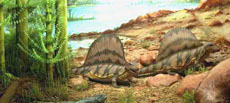 |
 |
 |
 |
 |
Produced
by the Population Genetics and Evolution class, Furman University |
||||
 |
 |
 |
 |
 |
Produced
by the Population Genetics and Evolution class, Furman University |
||||
 |
Gerobatrachus
hottoni |
 |
||
| Gerobatrachus
hotteni, first described in 2008, is a 'stem-batrachian' with
both frog-like and salamander-like characteristics (Anderson et al. 2008).
For this reason, it has sometimes been called the “frog-amander”
(Wikipedia, 2010). It had a fused ankle bones like a salamander, but a
wide frog-like skull. It also had an intermediate backbone, a characteristic
common to both frogs and salamanders (Wikipedia 2010). Gerobatrachus
is a temnospondyl, one of the groups of amphibians that radiated during
the Permian. However, its modern characters link it with two (frogs and
salamanders) of the three existing orders of amphibians, and some paleontologists
suggest that both modern groups evolved from these types of ancestors.
The third group of modern amphibians are the worm-like caecilians, which
are probably descended from another major group of ancestral amphibians,
the lepospondyls (Celesky 2008).
Page by Laura Snyder |
 |
| Gerobatrachus. Photo from:www.pharyngula.com | |
|
Anderson JS, Reisz RR, Scott D, Fröbisch NB, and Sumida SS. 2008. A stem batrachian from the Early Permian of Texas and the origin of frogs and salamanders. Nature 453:515–518 Celesky M. 2008. Gerobatrachus hotteni. The Hairy Museum of Natural History. Accessed on March 21, 2010. Wikipedia. 2010. Gerobatrachus. Accessed March 21, 2010. |